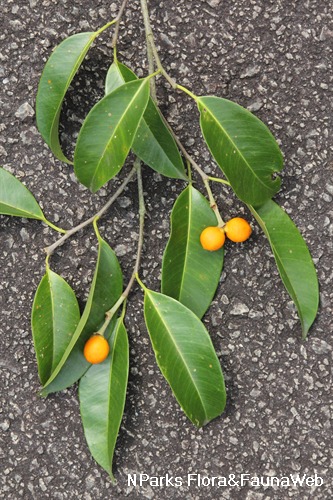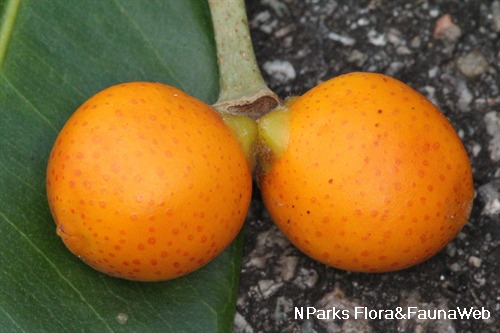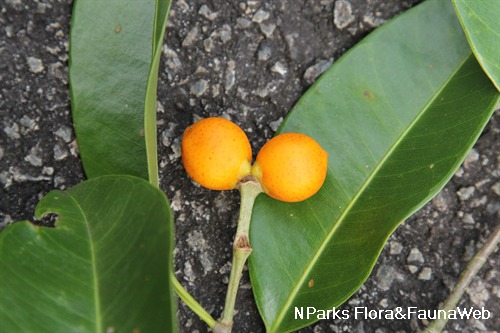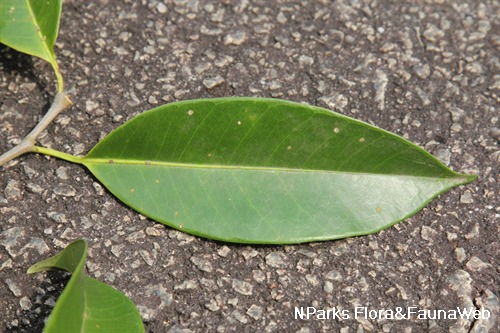
Back
Ficus stricta (Miq.) Miq.
| Family Name: | Moraceae |
| Synonyms: | Urostigma strictum Miq. |
Ficus stricta is a tall tree that grows to 40 m height. It produce smooth figs along the axils in pairs sometimes solitary, turns from yellow, to orange, to dark red or pink to purple upon maturity. Leaves are smooth, leathery, ranging from elliptic, oblong to oval-shaped.
Name
Classifications and Characteristics
| Plant Division | Angiosperms (Flowering Seed Plants) (Dicotyledon) |
|---|---|
| Plant Growth Form | Tree (Small (6m-15m)) |
| Lifespan (in Singapore) | Perennial |
| Mode of Nutrition | Autotrophic |
| Plant Shape | Irregular |
| Maximum Height | 40 m |
Biogeography
| Native Distribution | Southern China, Myanmar, Sumatra, Peninsular Malaysia, Singapore, Java. |
|---|---|
| Native Habitat | Terrestrial |
| Preferred Climate Zone | Tropical |
| Local Conservation Status | Native to Singapore (Critically Endangered (CR)) |
Description and Ethnobotany
| Growth Form | It is a tall tree that grows to 40 m tall, with aerial roots attached to the branches. |
|---|---|
| Trunk | Bark grey, smooth. Branches producing aerial roots; branchlets dull yellowish brown, straight. |
| Foliage | Its leaves are leathery, smooth, elliptic to oblong or oval-shaped measuring 8 - 14 cm long by 3.5 - 6 cm wide. Leaves are held on a thick, smooth petiole at 0.9 - 1.8 cm long. Stipules are smooth, measuring between 1.5 - 3 cm long. |
| Flowers | Enclosed inflorescence, known as synocnium which are produced by all Ficus sp. |
| Fruit | Figs are produced on the axils, in pairs sometimes solitary. The figs are smooth, turn to yellow, to orange, to dark red or pink to purple at maturity. |
| Habitat | Dry evergreen and evergreen forests, on sandstone up to 2000 m altitude. |
| Cultivation | Partial shade, likes constant moisture but well draining soil. Propagation by seeds or air layering. |
| Ethnobotanical Uses | Cultural / Religious: Heritage Tree: There are currently five individuals of Ficus stricta listed as Heritage Trees in Singapore. They can be found in Pulau Ubin and Changi. To find out more about these trees, please visit the Heritage Tree Register. |
Landscaping Features
| Landscaping | It is suitable for planting along roadsides, large parks and gardens and on slopes for stabilisation. |
|---|---|
| Desirable Plant Features | Ornamental Fruits |
| Landscape Uses | General, Suitable for Roadsides, Parks & Gardens, Coastal, Slope Stabilization |
Fauna, Pollination and Dispersal
| Fauna Pollination Dispersal Associated Fauna | Bird-Attracting, Caterpillar Moth Food Plant |
|---|---|
| Pollination Method(s) | Biotic (Fauna) |
| Seed or Spore Dispersal | Biotic (Fauna) |
Plant Care and Propagation
| Light Preference | Full Sun, Semi-Shade |
|---|---|
| Water Preference | Moderate Water |
| Plant Growth Rate | Slow |
| Rootzone Tolerance | Moist Soils, Well-Drained Soils |
| Propagation Method | Seed, Stem Cutting, Air-Layering |
Foliar
| Foliage Retention | Evergreen |
|---|---|
| Mature Foliage Colour(s) | Green |
| Mature Foliage Texture(s) | Leathery |
| Foliar Type | Simple / Unifoliate |
| Foliar Arrangement Along Stem | Alternate |
| Foliar Attachment to Stem | Petiolate |
| Foliar Shape(s) | Non-Palm Foliage (Elliptical, Oblong, Ovate) |
| Foliar Venation | Pinnate / Net |
| Foliar Margin | Entire |
| Foliar Apex - Tip | Acuminate |
| Foliar Base | Cuneate, Rounded / Obtuse |
Non - Foliar and Storage
| Stem Type & Modification | Woody |
|---|---|
| Root Type | Aboveground (Aerial Root), Underground (Tap Root) |
Floral (Angiosperm)
| Flower & Plant Sexuality | Unisexual Flowers , Monoecious |
| Flower Grouping | Cluster / Inflorescence |
|---|
| Flower Location | Axillary |
| Inflorescence Type | Syconium |
Fruit, Seed and Spore
| Mature Fruit Colour(s) | Orange, Pink, Purple |
|---|---|
| Mature Fruit Texture(s) | Smooth |
| Fruit Classification | Multiple Fruit |
| Fruit Type |
References
| References | Berg. C.C. & Corner. E.J.H (2005). Moraceae: Ficeae. Flora Malesiana, ser. 1 Seed Plants, vol. 17. Leiden: Naturalis Biodiversity Center. |
|---|
Image Repository
Others
| Master ID | 31228 |
|---|---|
| Species ID | 5623 |
| Flora Disclaimer | The information in this website has been compiled from reliable sources, such as reference works on medicinal plants. It is not a substitute for medical advice or treatment and NParks does not purport to provide any medical advice. Readers should always consult his/her physician before using or consuming a plant for medicinal purposes. |







